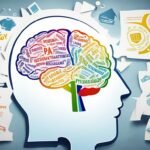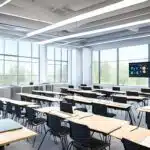Table of Contents
ToggleThe educational system in the USA has undergone significant changes over the years, shaping the way students learn and grow. From its early roots in the colonial era to the present day, the educational system in the USA has evolved to provide opportunities and access to education for all. Let’s dive into the history, development, and current state of the educational system in the USA.
Key Takeaways:
- The educational system in the USA has gone through significant changes over time.
- From the colonial era to the present day, efforts have been made to provide opportunities for all students.
- Public education, normal schools, and educational reform movements have played crucial roles in shaping the system.
- The educational system in the USA continues to face challenges, but progress is being made towards a more inclusive and equitable system.
- Advancements in educational technology offer new possibilities for innovative teaching methods and personalized learning.
Early Education in the USA
During the colonial era in the USA, education played a significant role in the New England colonies, particularly influenced by the Puritans. The Puritans placed great importance on education, as they believed that individuals should be able to read and interpret the Bible for themselves. To ensure this, they established schools in their communities.
While the New England colonies prioritized education, the situation was more haphazard in other regions. Various arrangements existed, such as church-supported schools, local schools organized by towns or parents, and private tutoring or homeschooling. These approaches to education varied depending on the community’s resources and priorities.
“The Puritans believed that education was crucial for cultivating individuals who could properly interpret Scripture and live according to their religious beliefs” – John Winthrop
Education in the New England colonies, driven by the Puritans’ religious convictions, laid some of the foundations for the educational system in the USA.
Notable New England Schools:
- Harvard College: Founded in 1636, Harvard College became the first institution of higher learning in the USA and an influential center for education.
- Roxbury Latin School: Established in 1645, this school became known for its rigorous curriculum, preparing students for college and future leadership roles.
- Dame Schools: These were small, informal schools run by women in their homes, teaching basic reading and writing skills to young children.
The dedication to education in the colonial era, particularly in the New England colonies, set the stage for the future development of the American educational system.
The Rise of Public Education
In the mid-19th century, the United States witnessed a significant shift towards public education. Most states recognized the importance of providing free education supported by taxes, ensuring that every child had access to learning opportunities. This shift was driven by the belief that educated citizens were essential for a prosperous and democratic society.
One of the influential pioneers of public education was the Massachusetts Bay Colony. They established a groundbreaking system of common schools that aimed to provide education to all children, regardless of their background or social class. The Massachusetts Bay Colony’s commitment to public education laid the foundation for the development of a comprehensive and inclusive educational system across the nation.
These common schools played a vital role in shaping the future of public education. Unlike the previous arrangements, where education was limited to certain groups or based on economic status, common schools were open to all. This inclusive approach not only fostered social mobility but also promoted equality among students.
The establishment of public education systems had several key components. Teachers were trained to effectively impart knowledge and guide students in their academic journey. The goal was to provide quality education that would equip students with the necessary skills and knowledge for success in life.
Mandating the attendance of children in schools was another crucial aspect of public education. By making it compulsory for children to attend school, states aimed to ensure widespread access to education. This helped address the issue of children from disadvantaged backgrounds being excluded from educational opportunities.
The rise of public education in the mid-19th century marked a significant turning point in the educational landscape of the United States. It laid the groundwork for the development of a comprehensive and inclusive educational system that aimed to provide equal opportunities to all students, regardless of their social status or background. Today, public education continues to play a vital role in shaping the future of the nation by preparing generations of students for success in an ever-changing world.
Benefits of Public Education
Public education offers several benefits to individuals and society as a whole. It fosters social mobility by providing equal opportunities for all students to acquire knowledge and skills. It promotes diversity and inclusion, enabling students from different backgrounds to learn, collaborate, and appreciate each other’s perspectives. Furthermore, public education contributes to the development of an informed and engaged citizenry, essential for a democratic society.
The Role of Normal Schools

Normal schools played a crucial role in training elementary-level teachers for public schools in the USA. These schools, initially reserved for men, were developed to teach teaching practices and develop a standardized national educational curriculum. Over time, normal schools evolved into teachers colleges and departments of education within universities.
Normal schools were established in the 19th century as specialized institutions focused on teacher training. Their purpose was to prepare individuals for the demanding task of educating young minds. With their emphasis on pedagogical instruction, normal schools provided aspiring teachers with the necessary skills and knowledge to excel in the classroom.
Curriculum development was a key component of normal schools’ mission. These institutions sought to set standards for teaching and create a unified approach to education. Through rigorous coursework and practical experience, future teachers learned effective instructional methods, classroom management techniques, and subject-specific content.
The diverse curriculum at normal schools encompassed subjects such as mathematics, science, literature, and history, enabling future educators to have a well-rounded foundation to impart on their students. Additionally, special attention was given to the development of teaching strategies that catered to the unique needs of young learners.
Impact on the Education System
Normal schools played a fundamental role in shaping the educational landscape of the USA. By elevating the quality of teacher training, these institutions ultimately impacted the learning experiences of countless students across the nation.
As normal schools evolved and transformed into teachers colleges and departments of education within universities, their influence expanded beyond elementary education. Teacher training programs expanded to cover various levels of education, from elementary to secondary and even post-secondary instruction.
By equipping teachers with the necessary skills and knowledge, normal schools contributed to the professionalization of teaching as a career. Their focus on pedagogical principles elevated the status of educators and helped establish teaching as a respected profession.
The Legacy Continues
Today, the legacy of normal schools lives on in the form of teachers colleges, departments of education, and other teacher training programs within universities. These institutions continue to play a vital role in preparing teachers for the challenges of the modern classroom.
| Benefit | Impact |
|---|---|
| Specialized Training | Equips teachers with skills and knowledge to succeed in the classroom. |
| Standardized Curriculum | Ensures consistent quality in education by establishing standardized teaching methods. |
| Elevating the Teaching Profession | Increases the professionalism and status of educators. |
| Expanded Educational Opportunities | Provides pathways for individuals to pursue careers in teaching and make a difference in students’ lives. |
Thanks to the enduring impact of normal schools, teacher training remains a critical focus within the field of education. By maintaining a commitment to curriculum development and pedagogical excellence, these institutions continue to shape the future of education in the USA.
Educational Reform Movements
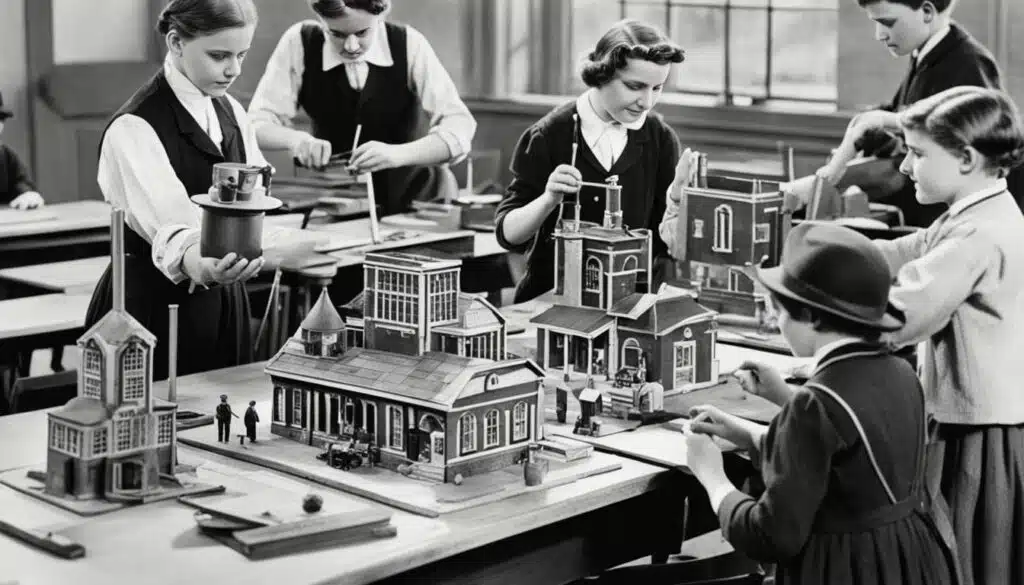
The Progressive Era in the USA marked a significant period of educational reform that sought to transform the learning experience for students. During this time, influential educational theorists such as Jean Piaget, Benjamin Bloom, Maria Montessori, and John Dewey emerged, advocating for equality, child-centered learning, and inquiry-based practice.
These progressive thinkers believed in creating an educational system that catered to the needs of each individual student, recognizing that every child learns differently. They emphasized the importance of hands-on experiences, critical thinking, and active engagement in the learning process.
“Education is not the filling of a pail, but the lighting of a fire.” – William Butler Yeats
Advocating for equality, these educational theorists argued that every child, regardless of their background or social class, deserved access to a quality education. They proposed reforms that aimed to bridge the gap between privileged and underprivileged students and provide equal opportunities for all.
Child-centered learning became the cornerstone of progressive education. It emphasized the importance of tailoring educational experiences to meet the individual needs and interests of students, promoting their active involvement in the learning process. The focus shifted from a teacher-centric approach to a student-centric one, with educators serving as guides and facilitators.
The innovative ideas put forth during the Progressive Era continue to shape education today. Many of the principles devised by these educational theorists are still incorporated into modern pedagogical practices. Child-centered learning, inquiry-based teaching, and the pursuit of educational equality remain essential goals of educators and policymakers.
Key Ideas of Educational Reform Movements:
- Equality in education for all students
- Child-centered learning
- Inquiry-based practice
- Hands-on learning experiences
- Critical thinking and problem-solving skills
- Active student engagement
- Inclusivity and diversity in the classroom
The contributions of these educational theorists have paved the way for a more student-focused and inclusive educational system. By continually striving for progress and implementing their ideas, educators today can better prepare students for active citizenship and equip them with the skills and knowledge necessary to thrive in an ever-changing world.
Challenges and Achievements in Education

The educational system in the USA has faced various challenges throughout its history. From segregation to gender inequality, these hurdles have shaped the course of education in the country. However, significant progress has been made to address these issues and create a more inclusive learning environment for all students.
Segregation in schools was a pervasive problem that limited access to quality education for marginalized communities. However, landmark Supreme Court cases, like Brown vs. Board of Education in 1954, challenged the legality of segregation and paved the way for desegregation efforts. This ruling emphasized the importance of equal educational opportunities for all students, regardless of race.
“The Supreme Court’s decision in Brown vs. Board of Education marked a turning point in the fight against segregation, setting a precedent for promoting equality in schools.”
In addition to tackling segregation, gender inequality also posed significant challenges in the educational system. Over time, efforts have been made to address this issue and ensure gender equality in schools. By providing equal opportunities for both male and female students, the USA has taken significant strides towards creating a more equitable learning environment.
Literacy rates have also been a key concern in the educational system. Efforts to improve literacy rates have focused on implementing effective teaching strategies, enhancing curriculum standards, and providing targeted interventions for struggling students. These initiatives have helped narrow the literacy gap and promote better educational outcomes.
Desegregation and inclusive practices have yielded positive results in providing equal educational opportunities for all. By dismantling barriers and fostering an environment that celebrates diversity, the educational system in the USA continues to progress towards a more inclusive future.
| Literacy Rates | Gender Equality | |
|---|---|---|
| Before Desegregation | Unequal access to education, particularly for marginalized communities | Gender bias in curriculum and limited opportunities for female students |
| After Desegregation | Improvement in literacy rates across diverse student populations | Efforts to promote gender equality and equal access to educational opportunities |
As the educational system in the USA continues to evolve, it is crucial to address the remaining challenges and work towards greater equality and inclusivity. By prioritizing these goals, the country can build a stronger educational foundation for future generations.
Evolution of Higher Education
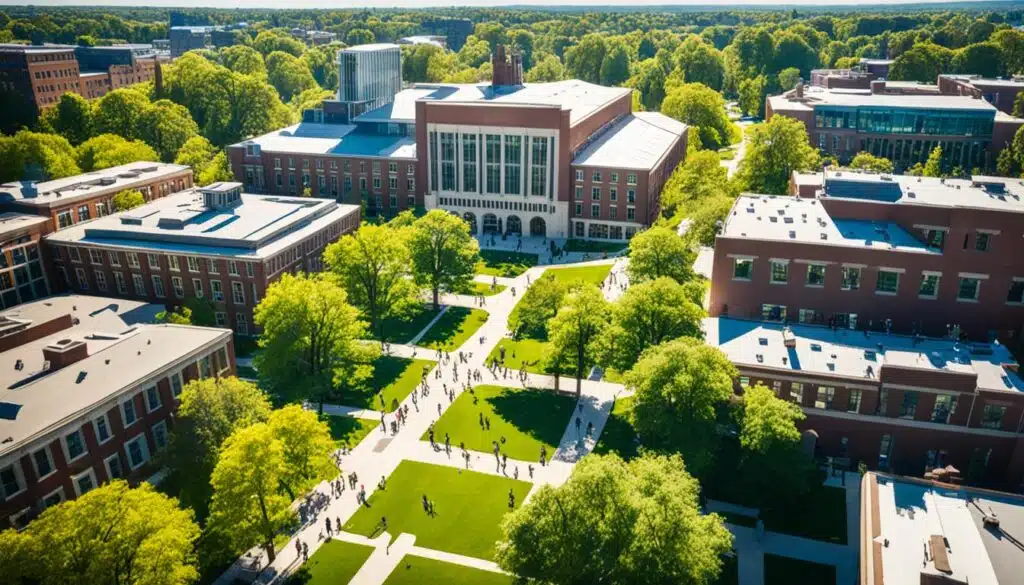
The higher education system in the USA has undergone a remarkable evolution, marked by the establishment of colleges and universities that have shaped the educational landscape. Among these institutions, the Ivy League universities, including esteemed names like Harvard and Yale, have played a pivotal role in providing exceptional higher education opportunities.
As centers of academic excellence, the Ivy League universities have garnered international recognition and prestige. These institutions boast a rich history and tradition of producing some of the world’s most influential scholars, thinkers, and leaders. With rigorous academic programs and a commitment to intellectual exploration, Ivy League universities remain at the forefront of higher education.
In addition to the Ivy League, prep schools have emerged as pivotal institutions in preparing students for admission into these prestigious universities. Prep schools, renowned for their dedication to academic excellence and college preparation, serve as feeder schools for Ivy League institutions and other elite colleges and universities. They provide students with a solid educational foundation, rigorous coursework, and personalized guidance to enhance their chances of gaining acceptance into their desired institutions.
Prep schools play a vital role in cultivating the intellectual curiosity and ensuring the academic readiness of students aspiring to attend Ivy League universities and other esteemed higher education institutions. These schools provide comprehensive college counseling, rigorous coursework, and a supportive environment that fosters intellectual growth and personal development.
Prep schools not only focus on academic excellence but also provide opportunities for extracurricular activities, including sports, the arts, and community service. This holistic approach produces well-rounded students equipped with the skills and experiences essential for success in higher education and beyond.
Benefits of Attending Ivy League Institutions:
- Prestige and global recognition
- Exceptional academic programs and faculty
- Extensive research opportunities
- Networking and connections
- Access to influential alumni networks
Top Ivy League Universities:
| University | Location | Established |
|---|---|---|
| Harvard University | Cambridge, Massachusetts | 1636 |
| Yale University | New Haven, Connecticut | 1701 |
| Princeton University | Princeton, New Jersey | 1746 |
| Columbia University | New York City, New York | 1754 |
| University of Pennsylvania | Philadelphia, Pennsylvania | 1740 |
| Cornell University | Ithaca, New York | 1865 |
| Dartmouth College | Hanover, New Hampshire | 1769 |
| Brown University | Providence, Rhode Island | 1764 |
Whether attending Ivy League universities or other esteemed colleges and universities, higher education in the USA offers students an environment that fosters intellectual growth, critical thinking, and personal development. The rich history and commitment to academic excellence make the higher education system in the USA a global leader in producing future leaders and change-makers.
Education in the South

Educational practices in the southern region of the United States exhibited distinct characteristics compared to other parts of the country. Wealthy families in the South had the means to provide their children with exclusive educational opportunities. Many of them chose to hire private tutors or send their children to prestigious schools in England or Scotland to ensure a high-quality education.
However, public universities also played an essential role in the educational landscape of the South. Several southern states established public universities to offer affordable higher education options for students from all backgrounds. These institutions became pillars of educational excellence and helped shape the intellectual and cultural fabric of the region.
In addition to private tutors and public universities, free schools were introduced in the South to provide education primarily to white children. These schools, supported by local communities and often connected to religious organizations, aimed to impart fundamental knowledge and skills to young learners.
Unfortunately, a dark aspect of education in the South was the persistent racial segregation that plagued the region for many years. Black students were denied access to the same educational opportunities as their white counterparts, leading to years of educational inequality and social injustice.
The Influence of Wealthy Families and Private Tutors
Wealthy families in the South wielded considerable influence when it came to the education of their children. By hiring private tutors, they ensured personalized instruction and tailored education plans for their offspring. This educational approach allowed wealthy children to obtain a well-rounded education that catered to their specific needs and interests.
The involvement of private tutors also extended beyond traditional academics. Students under their tutelage often received instruction in music, art, and other cultural pursuits, fostering a holistic and enriched educational experience.
“Private tutors allowed wealthy families to provide their children with a premier education while maintaining control over the curriculum and pedagogical methods.”
The Impact of Public Universities
The establishment of public universities in the South brought new educational opportunities to a wider range of students. These institutions became centers of learning, research, and innovation, offering degrees in various disciplines.
Public universities in the South have produced renowned scholars, intellectuals, and leaders who have contributed significantly to the development of their communities and the nation as a whole. These institutions remain vital in providing accessible and affordable higher education options for students today.
Racial Segregation and Educational Inequality
Despite the strides made in educational access, racial segregation persisted in the South’s schools for many years. African American students were subjected to separate and inferior education facilities, effectively denying them the same opportunities for academic and personal growth as their white counterparts. This systemic discrimination inflicted long-lasting damage on generations of black students and perpetuated educational inequality.
It wasn’t until landmark Supreme Court cases, such as Brown v. Board of Education, that the practice of racial segregation in schools was eventually deemed unconstitutional. These legal victories marked significant milestones in the fight for equality in education and propelled the nationwide movement towards integrated schools.
The Role of Public Schools Today
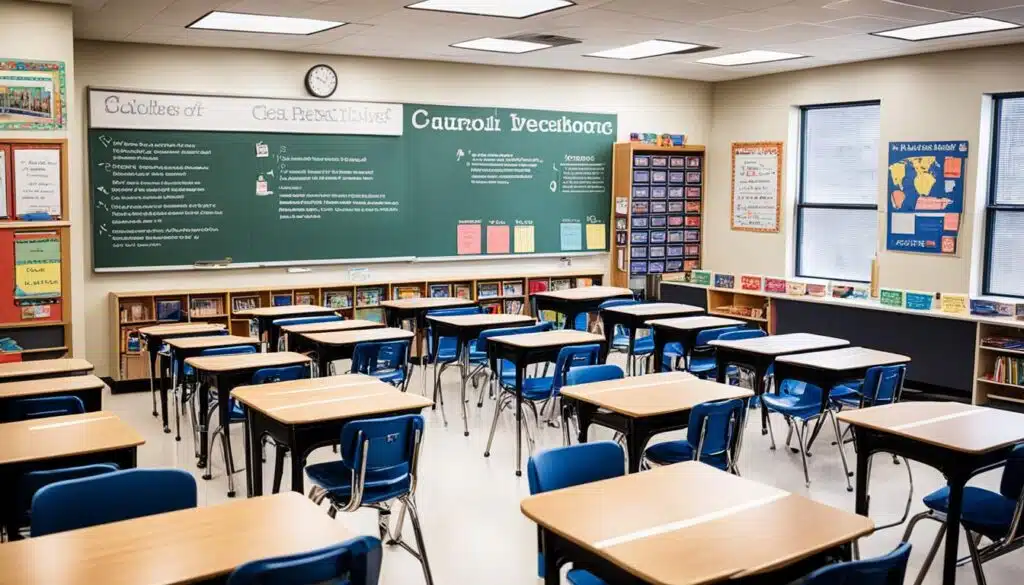
During the Reconstruction era after the Civil War, public school systems were rebuilt in the South, but they remained racially segregated. The legacy of racial segregation in public education had lasting effects on the educational opportunities and achievements of Black students. The establishment of racially segregated schools during this time created deep divisions and disparities in access to quality education.
However, over time, efforts were made to address these inequities. In landmark cases such as Brown v. Board of Education in 1954, the Supreme Court ruled that racially segregated schools were unconstitutional, marking a significant shift toward desegregation in public education systems across the country.
Today, public schools play a vital role in providing education to students across the USA. While the era of racially segregated schools has ended, racial and socioeconomic disparities persist within public school systems. It is crucial to continue striving for equity and inclusivity in education to ensure that every student has equal opportunities to succeed.
“Education is the most powerful weapon which you can use to change the world.” – Nelson Mandela
Addressing Disparities
Public school systems today are working to address the disparities that exist in education. Efforts are being made to close the achievement gap among students of different racial and socioeconomic backgrounds. This includes implementing policies and programs that provide additional support and resources to students who are historically disadvantaged.
The availability of quality education should not be determined by a student’s zip code or socioeconomic status. Schools are investing in initiatives to promote diversity, inclusion, and cultural competency among faculty and staff. They are also implementing evidence-based practices to improve teaching and learning outcomes for all students.
Funding and Resources
Public schools are primarily funded through general taxes and government funding. However, the allocation of resources can vary significantly between school districts, leading to educational disparities. Schools in lower-income areas often have fewer resources, which can impact the quality of education they can provide.
Efforts are being made to ensure equitable distribution of resources, including increased funding for schools in disadvantaged areas and the implementation of targeted programs to support underprivileged students. Additionally, educational technology has become an essential tool in bridging the digital divide and providing equal access to learning opportunities for students, regardless of their background.
Preparing Future Generations
Public schools have the responsibility of preparing students for future success. This includes equipping them with the knowledge, skills, and values necessary to become informed, engaged citizens. Public schools strive to provide a well-rounded education that fosters critical thinking, creativity, and social-emotional development.
Collaboration between schools, families, and communities is crucial in creating an environment that supports student success. By working together, stakeholders can create a strong foundation for educational achievement and ensure that every student has the opportunity to reach their full potential.
| Racially Segregated Schools | Desegregated Schools | |
|---|---|---|
| Access to Quality Education | Unequal access based on race Disparities in resources and opportunities |
Increased access for all students Efforts to address disparities |
| Diversity and Inclusion | Separation based on race Limited exposure to different perspectives |
Promotion of diversity and inclusion Cultural competency initiatives |
| Educational Funding | Funding inequities Less resources in disadvantaged areas |
Efforts to ensure equitable funding Targeted support for underprivileged students |
| Preparation for the Future | Limited opportunities for success in segregated environments | Focus on holistic education Development of critical thinking and essential skills |
Challenges and Future Directions
The educational system in the USA faces various challenges that require attention and strategic solutions. Addressing these challenges will contribute to creating a more equitable and inclusive educational landscape. Two critical areas that demand focused efforts are achievement gaps and the need for effective educational policies.
Achievement Gaps
One of the major challenges in the educational system is the presence of achievement gaps among students. Achievement gaps refer to disparities in academic performance and educational outcomes between different groups of students based on factors such as race, ethnicity, socioeconomic status, and English language proficiency.
Reducing achievement gaps is crucial for ensuring equal opportunities for all students and fostering social and economic mobility. Efforts should be made to identify the root causes of these gaps and implement targeted interventions to address them. This includes providing additional support and resources to students who are at risk of falling behind, promoting culturally responsive teaching practices, and creating inclusive learning environments.
Effective Educational Policies
The development and implementation of effective educational policies play a crucial role in shaping the education system and ensuring its success. Educational policies encompass a wide range of initiatives, including curriculum standards, assessment practices, teacher training, and school funding.
It is essential for policymakers to prioritize evidence-based approaches and research-backed strategies when formulating educational policies. This involves understanding the diverse needs of students, engaging stakeholders such as educators and parents in the decision-making process, and regularly evaluating the impact of policies to make necessary adjustments.
Advancements in Educational Technology
Advancements in educational technology offer promising opportunities to transform teaching and learning experiences. Educational technology tools provide educators with innovative ways to engage students, personalize instruction, and cater to diverse learning styles.
Integrating educational technology into classrooms can enhance student learning outcomes, foster creativity and critical thinking, and enable collaboration among peers. From interactive online courses to virtual reality simulations, technology has the potential to revolutionize education and bridge gaps in access to quality resources.
However, it is crucial to ensure equitable access to educational technology for all students, regardless of their socioeconomic background. This includes providing necessary infrastructure, resources, and support to schools and educators to effectively utilize educational technology tools in the learning process.
Creating an Inclusive and Equitable Educational System
As the educational system in the USA tackles challenges related to achievement gaps, educational policies, and educational technology, it is vital to work towards creating an inclusive and equitable educational system.
This means fostering a learning environment that embraces diversity, empowers all students to succeed, and provides equal opportunities for academic growth and development. It requires ongoing collaboration between educators, policymakers, parents, and communities to dismantle systemic barriers and create educational experiences that are accessible, supportive, and meaningful for every learner.
As we navigate the future of education, it is imperative to continually assess and adapt our approaches to meet the evolving needs of students and society. By addressing the challenges of achievement gaps, enhancing educational policies, and harnessing the power of educational technology, we can pave the way for a more equitable and enriching educational system in the USA.
Also Read : How To Prepare For RRB ALP Exam?
Conclusion
The educational system in the USA has undergone significant transformations throughout its history, driven by historical, social, and cultural influences. From its humble beginnings in the colonial era to the present day, the goal has always been to provide quality education to students across the country. However, challenges persist, and the need for an equitable and inclusive educational system remains.
Efforts to establish public education, train teachers, and promote educational reform have shaped the educational system in the USA. Landmark court cases, such as Brown vs. Board of Education, have addressed issues of segregation and led to progress in providing equal opportunities for all students. Public schools and colleges have played crucial roles in shaping the future of education in the country.
While the educational system in the USA faces ongoing challenges such as achievement gaps and the need for effective educational policies, advancements in educational technology offer new possibilities for personalized learning and innovative teaching methods. The commitment to providing a quality education for all remains at the forefront of educational initiatives in the USA, with a focus on creating an inclusive and equitable educational system.
FAQs
Q: What is the educational system in the USA like?
A: The educational system in the USA consists of different levels such as elementary, middle school, high school, and higher education institutions like colleges and universities.
Q: How many grades are there in the K-12 system in the USA?
A: The K-12 system in the USA includes 13 grades, from kindergarten to 12th grade.
Q: What does it mean to graduate in the educational system?
A: To graduate means to successfully complete a level of education or a course of study, typically resulting in a diploma or degree.
Q: What is higher education in the USA?
A: Higher education in the USA refers to education beyond high school, usually pursued at colleges, universities, or other post-secondary institutions.
Q: How is compensation for educators in the educational system determined?
A: Compensation for educators in the educational system is often determined by factors such as experience, qualifications, and the specific school district or institution they work for.
Q: What is an academic year in the context of education?
A: An academic year is the period during which students attend school or college, typically consisting of two semesters or three quarters.
Q: What is the role of administrators in the educational system?
A: Administrators in the educational system oversee school operations, manage staff, develop policies, and ensure a conducive learning environment for students.
Q: How do students use glossaries in their studies?
A: Students use glossaries to look up the meanings of specific terms or concepts, aiding in their understanding of the subject matter being taught.


